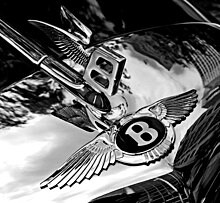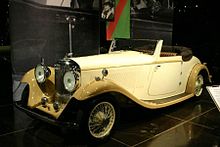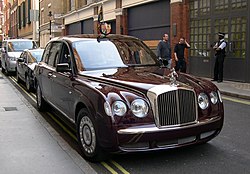Bentley
| This page has an infobox that is missing one or more vital fields and needs to be updated. Please consult the relevant WikiProject or this category to find the appropriate usage. |
| File:Bentley logo.svg | |
| Company type | Subsidiary and marque of Volkswagen Group |
|---|---|
| Industry | Manufacturing |
| Founded | 18 January 1919 |
| Founder | Walter Owen Bentley |
| Headquarters | |
Area served | Worldwide |
Key people | Dr. Franz-Josef Paefgen, CEO |
| Products | Cars |
Number of employees | 4000 (2006) |
| Parent | Volkswagen Group |
| Website | BentleyMotors.com |


Bentley Motors Limited is an English manufacturer of luxury automobiles and Grand Tourers. Bentley Motors was founded in England on 18 January 1919 by Walter Owen Bentley, known as W.O. Bentley or just "W.O." (1888–1971). He was previously known for his successful range of rotary aero-engines in World War I, the most famous being the Bentley BR1 as used in later versions of the Sopwith Camel. Since 1998 the company has been owned by the Volkswagen Group (Volkswagen AG) (VWAG) of Germany.
Bentley as a separate company (1919-1931)
Before World War I W.O. Bentley had been in partnership with his brother H.M. Bentley selling French D.F.P. cars but he had always wanted to design and build his own range of cars bearing his own name. In August 1919 Bentley Motors Ltd was registered and a chassis, with dummy engine, was exhibited at the London Motor Show in October that year. [1]. An engine was built and running by December and orders taken for deliveries starting in June 1920. However, development took longer than estimated and the first cars were not ready until September 1921.[1]
The company was always underfunded and Bentley turned to millionaire Woolf Barnato for help in 1925. As part of a re-financing deal, leaving him effectively owning the company, Barnato became chairman. A great deal of Barnato's fortune was devoted to keeping Bentley afloat but the Great Depression destroyed demand for the company's expensive products, and it was finally sold to Rolls-Royce in 1931.
The Bentley Boys
A group of wealthy British automobile aficionados known as the "Bentley Boys" (Woolf Barnato, Sir Henry Birkin, steeplechaser George Duller, aviator Glen Kidston, automotive journalist S. C. H. "Sammy" Davis, and Dr. Dudley Benjafield among them) kept the car's reputation for high performance alive. At one point, on a bet, Barnato raced Le Train Bleu from Cannes to Calais, then by ferry to Dover and finally London, travelling on public highways with normal traffic, and won ; the special-bodied 6½ Litre car became known as the Blue Train Bentley. Thanks to the dedication of this group to serious racing, the company, located at Cricklewood, north London, was noted for its four consecutive victories at the 24 hours of Le Mans from 1927 to 1930. Their greatest competitor at the time, Bugatti, whose lightweight, elegant, but fragile creations contrasted with the Bentley's rugged reliability and durability, referred to them as "the world's fastest lorries".
Car models
The original model was the 3 litre, but as customers put heavier bodies on the chassis a larger 4½ litre model followed. Perhaps the most iconic model of the period is the 4½ Litre "Blower Bentley", with its distinctive supercharger projecting forward from the bottom of the grille. Uncharacteristically fragile for a Bentley, it was not the racing workhorse, the 6½ Litre was. It became famous in popular media as the vehicle of James Bond in the original novels, but not in film; however John Steed in the television series The Avengers did drive a Bentley.
- 1921-1929 3 Litre
- 1926-1930 4½ Litre & "Blower Bentley"
- 1926-1930 6½ Litre
- 1928-1930 6½ Litre Speed Six
- 1930-1931 8 Litre
- 1931 4 Litre
Bentleys of the Rolls-Royce era (1931-1998)





Rolls-Royce had bought Bentley secretly using a company named the British Central Equitable Trust and not even Bentley himself knew the true identity of the purchaser until the deal was completed.[1] A new company, wholly owned by Rolls-Royce, was formed called Bentley Motors (1931) Ltd with W.O. Bentley himself little more than an employee and he left to join Lagonda in 1935 when his contract was up for renewal. The Cricklewood factory was closed and sold and production moved to the Rolls-Royce works in Derby.
When a new Bentley car appeared in 1933, the 3½ Litre, it was a sporting variant of the Rolls-Royce 20/25 and although disappointing some traditional customers, it was well received by many others and even Bentley himself was reported as saying "Taking all things into consideration, I would rather own this Bentley than any other car produced under that name."[1]
After World War II, production of Rolls-Royce and Bentley cars was moved to an ex-wartime engine factory in Crewe, Cheshire. Bentleys became increasingly a Rolls-Royce without the distinctive grille and with a lower price tag and by the 1970s and early 1980s sales had fallen badly with at one time less than 5% of production carrying the Bentley badge.[1]
The parent company failed in 1970 following problems with aero engine development and the car division was floated off to become Rolls-Royce Motors Ltd and remained independent until bought by Vickers in August 1980.
In the 1980s Bentley became a separate, high performance car line once again typified by the 1980 Mulsanne. The new sporting image created a new interest in the name and sales as a proportion of output started to rise. In 1986 the Rolls-Royce:Bentley ratio was 60:40 and in 1991 50:50 [1].
The Bentley factory in Crewe, Cheshire, is still known in the town by the name "Royce's". For more on Bentley Motors from 1931 to 1998, see Rolls-Royce and Rolls-Royce Motors.
Car models
- 1933–1937 3½ Litre
- 1936–1939 4¼ Litre
- 1939–1941 Mark V
- 1939 Mark V
- 1946–1952 Mark VI
- 1952–1955 R Type and Continental
- 1955–1959 S1 and Continental
- 1959–1962 S2 and Continental
- 1962–1965 S3 and Continental
- 1965–1980 T-series
- 1971–1984 Corniche
- 1984–1995 Continental — convertible
- 1992–1995 Continental Turbo
- 1984–1995 Continental — convertible
- 1975–1986 Camargue
- 1980–1987 Mulsanne
- 1984–1988 Mulsanne L limousine
- 1982–1985 Mulsanne Turbo
- 1987–1992 Mulsanne S
- 1984–1992 Eight — lower-priced model
- 1985–1995 Turbo R — turbocharged performance version
- 1991–2002 Continental R — turbocharged 2-door model
- 1999–2003 Continental R Mulliner — performance model
- 1994–1995 Continental S — intercooled
- 1992–1998 Brooklands — improved Eight
- 1996–1998 Brooklands R — performance Brooklands
- 1994–1995 Turbo S — limited-edition sports model
- 1995–1997 Turbo R — updated Turbo R
- 1996 Turbo R Sport — limited-edition sports model
- 1995–2003 Azure — convertible Continental R
- 1999–2002 Azure Mulliner — performance model
- 1996–2002 Continental T — short wheelbase performance model
- 1999 Continental T Mulliner — firmer suspension
- 1997–1998 Bentley Turbo RT — replacement for the Turbo R
Volkswagen Group ownership

In 1998, Rolls-Royce and Bentley Motors were purchased from Vickers (its owner since 1980) by Volkswagen Group for £430 million, after bidding against BMW. BMW had recently started supplying components for the new range of cars, notably V8 engines for the Bentley Arnage and V12 engines for the Rolls-Royce Silver Seraph. The Rolls-Royce name was not included in VW's purchase; it was instead licensed to BMW (for £40 million) by the Rolls-Royce aero engine company.
BMW and Volkswagen came to an agreement whereby Volkswagen would manufacture both Bentley and Rolls-Royce cars until the end of 2002, whereupon the right to build Rolls-Royce cars would be BMW's alone. During this period, Volkswagen reduced its reliance on BMW as a supplier: as of 2003, BMW engines are no longer used in Bentley cars.
Modern Bentleys


In 2002, Bentley presented Queen Elizabeth II with an official State Limousine to celebrate the Golden Jubilee. In 2003, Bentley's 2-door convertible, the Bentley Azure, ceased production, and the company introduced the Bentley Continental GT, a large luxury coupe. The car is powered by a version of VW's W-12 engine.
Demand had been so great that the factory at Crewe, Cheshire, was unable to meet orders despite an installed capacity of approximately 9500 vehicles per year. There was a waiting list of over a year for new cars to be delivered. Consequently, production of the new Flying Spur, a four-door version of the Continental GT, was assigned to the Transparent Factory, where the VW Phaeton luxury car is also assembled. This arrangement ceased at the end of 2006, and all car production reverted to the Crewe plant.
In April 2005, Bentley confirmed plans to produce a 4-seat convertible model, the Azure, derived from the Arnage Drophead Coupe prototype, at Crewe beginning in 2006. By the autumn of 2005, the convertible version of the successful Continental GT, the Continental GTC was also presented. These two models were successfully launched in late 2006.
Bentley sales continued to increase and in 2005 were 8,627 sold worldwide, 3,654 of which were sold in the United States. In 2007, with sales of 10,014, the 10,000 cars per year threshold was broken for the first time in the company's history. For 2007 a record profit of €155 million was also announced. [2]
- 1998– Arnage saloon
- 1999– Hunaudieres Concept
- 2002– State Limousine
- 2003– Continental GT coupé
- 2005– Continental Flying Spur saloon
- 2006– Azure convertible
- 2006– Continental GT convertible
- 2008– Bentley Brooklands coupé
- 2008– Continental GT Speed coupé
- 2008– Bentley Continental Flying Spur Speed saloon
The current Board of Management consists of Dr. Franz-Josef Paefgen, Chairman and Chief-Executive, Dr. Ulrich Eichhorn, Engineering, Stuart J. McCullough, Sales & Marketing, Douglas G. Dickson, Manufacturing, Christine A. Gaskell, Personnel and Juergen Hoffmann Finance.
Current Bentley Racing
In 2001-2003, the Bentley Speed 8 enjoyed a successful racing streak in the Le Mans series.
Future Cars
Since the successful launch of the Continental GT, GTC and Flying Spur, producing a new halo model to replace the Arnage has become a priority, as against the Rolls-Royce Motor Cars and Maybach rivals the car is dated. A new Arnage would most probably be based on a chassis designed for the next generation Audi A8, due to its versatility. The new car is expected for the 2010 model year, and is said to take styling cues from the Bentley State Limousine[citation needed].
In 2008 and 2009 the Continental GTC and Flying Spur are widely expected to receive the changes already made to the Continental GT, with a new front splitter and chrome headlight surrounds among other changes.
Since Bentley's induction into the VW Group, rumours of an SUV style vehicle have repeatedly surfaced. These have been shot down by Bentley employees on the basis that the idea would not fit into their future plans and also the fact that the manufacturing facilities are already running at full capacity.
Borrowing hybrid technology developed by Bentley owners VW Group is another focal point as the trend towards hybrid cars is expanding year on year.
References
Further reading
- Richard Feast - Kidnap of the Flying Lady: How Germany Captured Both Rolls-Royce and Bentley (Motorbooks, 2003) ISBN 0-7603-1686-4
- Andrew Frankel - Bentley - the Story (Redwood Publishing, 2005) ISBN 0-9517751-9-7



